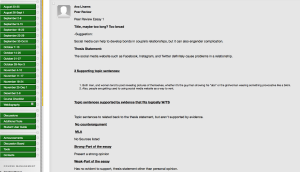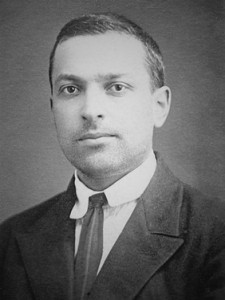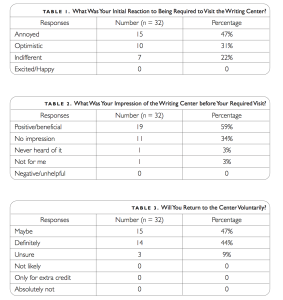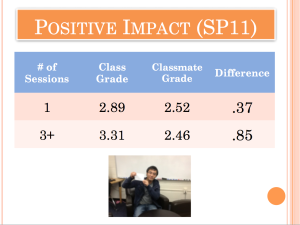
The lecture format as an effective pedagogical method is now considered a thing of the past. Most teachers prefer a focus on cooperative and collaborative classroom activities.
Cooperative learning, based on the social development theory of education advocated by groundbreaking psychologist Lev Vygotsky, has been one of the most – if not the most important theory and method used in the field of development and ESL education since at least the 1960s. Cooperative learning is a teaching strategy in which small groups of students use learning activities to find answers to problems and collectively combine their knowledge to arrive at solutions. According to Kenneth Bruffee, such a method sprung from Vygotsky’s work because it showed teachers that “reflective thought is public or social conversation internalized,” and that [t]o think well as individuals, we must learn to think well collectively – that is we must learn to converse well” (640). This was the launching point for cooperative learning in which students work collectively to improve both as a community and individually. While a 1960s and 70s definition of cooperative learning came from a Vietnam-era in which teachers were looking to democratize education and “eliminate socially destructive authoritarian social forms” (Bruffee 636), by the 1980s, the idea of social conversation became accepted when more American teachers discovered it as a way of helping poorly prepared academic students who had difficulty adapting to the “traditional” or “normal” conventions of the college classroom: “It was the traditional classroom that seemed to have left these students unprepared in the first place” (267). According to Nicole Tong, the head of developmental education at Northern Virginia Community College, today, for most developmental educators, Vygotsky and cooperative learning is still an integral part of the classroom space. Such cooperative methods include “tutoring inside and outside of classrooms” and working together as a way of discovering that their voices are “worthy of consideration.”
In considering these multiple reasons for taking up the challenge of cooperative learning, developmental and educational psychologists have also found the technique to be a break from two traditional ways of thinking about writing education – that solo writing and the lecture format can be sufficient in teaching students to improve their work. According to George Slavich and Philip Zimbardo, lecturing is still the most common format used in higher education, yet educational psychology shows that it “accounts for only a small part of the pedagogical progress that has been made” (570), and that all contemporary theories derive from Piaget and Vygotsky which “emphasize the importance of active engagement and social interactions for promoting learning” (576). Studies have also shown that students are proven to learn more, have better attendance, persistence, and engagement in classrooms with collaborative and cooperative learning rather than students taking a lecture-based class (570). This research shows that cooperative learning can become a democratic process to make education more effective for students who failed in traditional classrooms. Although there is some slight pendulum-swing on the lecture format, with some teachers still arguing for the lecture as a way to engage students in higher-order thinking, Rebecca Shuman points out that a lecture is frequently what students want, as it allows them to disengage from the material and sit back “counting minutes” until class is over. She advocates that a cooperative classroom space give students what they need, in forcing “involvement, investment, and sometimes even retention.”
In addition to a strong movement away from the lecture approach, the idea of writing as a solo activity has also fallen out of favor. Perry Klein and Tracey Lealock have noted that “[u]naided, human cognition” on an individual level has a small capacity for storage, timing, and processing, and that nearly all writing and learning activities (aside from tests) involve social activity (136). In fact, studies have shown that cooperative learning allows members to pool knowledge, “share cognitive load among members,” and check each others’ thinking for errors (134). This leads to texts that are more accurate linguistically and writing that contains more new ideas as members learn and refine new ideas (140-141). Jehangir’s research concurs, noting that “‘there is a growing sense that teaching and learning don’t really happen unless there is some kind of building relationship – not only between teacher and students but between teachers, students, and subject’” (91). Collaborative writing even has the benefit of getting “richer thinking and more voices into solo writing as well,” according to Elbow (267). With all of this said, the theory of writing as a solo activity that can be improved through lectures has been (almost) fully relegated to the past.
With cooperative learning now being a defining pedagogical model for developmental and ESL students, there are still some trends that are being discussed within the field. One such topic for discussion is that cooperative learning must be more than simple group work – just putting students into groups in class will not necessarily foster the types of gains expected by Vygotsky’s theory. For example, Jehangir notes that for real cooperative learning, a teacher must facilitate, teach, and familiarize students with the process of working together (93). Katherine Mason also notes that it is not as simple as group work, stating that teachers must model appropriate feedback for group work, otherwise students might sit silently without participating effectively (56-57). Elbow argues that in particularly effective cooperative work, switching drafts back and forth between one or more writers, which helps to “stop the stifling of minority voices,” is necessary to make sure that everyone has their voice heard within the writing (266). The last trend in facilitating cooperative learning now deals with online learning, in which both Mason and Klein and Lealock advocate for collaborative online submissions to improve student writing. Mason has students respond to each others’ paper proposals online, which she says leaves students with fresh ideas that she, as a teacher, wouldn’t have considered (55). Klein and Lealock argue that online learning activities lead to higher-quality discussions and written contributions, as students draw on a variety of resources, “including other discussants’ prior contributions” in their own posts (146). Few teachers today deny the power of cooperative education.
Vygotsky and a cooperative theory of learning has strongly influenced my own classroom; as I’ve mentioned in my other posts, I’m still figuring out how to best incorporate such work in a way that is meaningful, and hope to make such work more useful. The research for this paper has gotten me closer, I think, to defining a pedagogy of cooperative work. However, one thing I find discouraging are the many social and learning disabilities that my students face. Working at any college, but particularly a community college, means facing students with a variety of learning needs. When students come to me with accommodation letters outlining issues such as severe depression and autism, I wonder how (or if) they will be able to work in groups in a way that will be useful to themselves and the majority of their classmates. Most students work well in groups, but some absolutely resist group work, projects, or even peer review. As Nicole Tong points out, our students “have [different] academic needs and the way to broach these gaps” cannot be approached as if they are one student body, but must be treated individually. Therefore, can cooperative learning become problematic when we start to consider the extremely varied needs of our students?
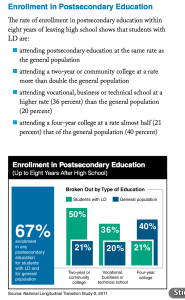
According to this data published by the National Center for Learning Disabilities in 2014, 67 percent of students with learning disabilities are enrolled in higher education at some time (the same as the general population), yet they attend community colleges at twice the rate of the general population, creating questions about what theories and methods will work.
While I certainly try to consider all learning needs and absolutely vary my teaching methods to meet the differing learning styles of my students, if most (or all) of the research says we need to involve our students in cooperative learning, more research must be done on how to deal with a population of students dealing with diagnoses of ADHD, autism, and depression on a greater scale than ever before. I am a strong advocate for cooperative learning, but I believe the research behind this issue is failing in one major capacity that needs further investigation.
Works Cited
Bruffee, Kenneth. “Collaborative Learning and the ‘Conversation of Mankind.’” College English 42.7 (1984): 635-652. Print.
Elbow, Peter. “Using the Collage for Collaborative Writing.” Teaching Developmental Writing. Ed. Susan Naomi Bernstein. 3rd ed. Boston: Bedford-St. Martin’s, 2007. 261-268. Print.
Jehangir, Rashne. “Cooperative learning in the multicultural classroom.” Theoretical perspectives for developmental education. Ed. J. L. Higbee, & D. B. Lundell. Minneapolis, MN: University of Minnesota, General College, Center for Research in Developmental Education and Urban Literacy, 2001. 91-99. Print.
Klein, Perry D., and Tracey L. Lealock. “Distributed Cognition as a Framework for Understanding Writing.” Past, Present, and Future Contibutions of Cognitive Writing Research to Cognitive Psychology. Ed. Virginia Wise Berninger. New York: Psychology Press Taylor and Francis Group, 2012. 133-152. Print.
Mason, Katherine. “Cooperative Learning and Second Language Acquisition in First-Year Composition: Opportunities for Authentic Communication among English Language Learners.” Teaching English in the Two Year College 34.1 (2006): 52-58. Web.
Schuman, Rebecca. “Professors Shouldn’t Teach To Younger Versions of Themselves.”Slate.com. Slate 21 Oct. 2015. Web. 23 Oct. 2015.
Slavich, George, and Philip G. Zimbardo. “Transformational Teaching: Theoretical Underpinnings, Basic Principles, and Core Methods.” Educational Psychological Review 24 (2002): 569-608. Print.
Tong, Nicole. Personal interview. 20 Oct. 2015.
Vygotsky, Lev. Mind in Society. Cambridge: Harvard University Press, 1978. Print.
